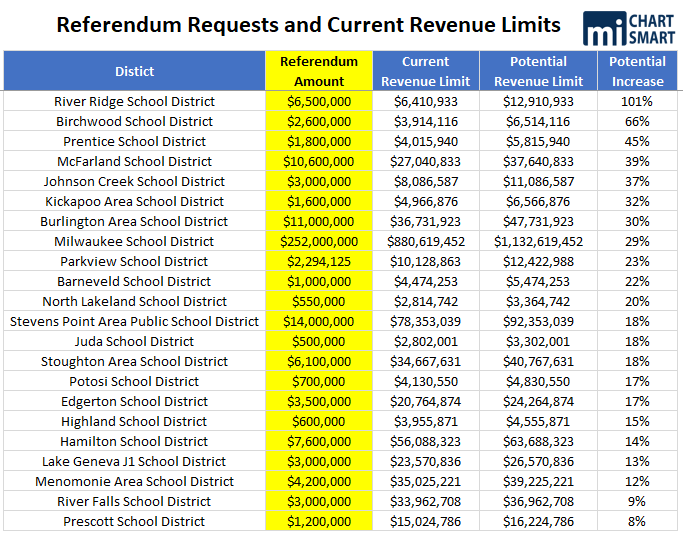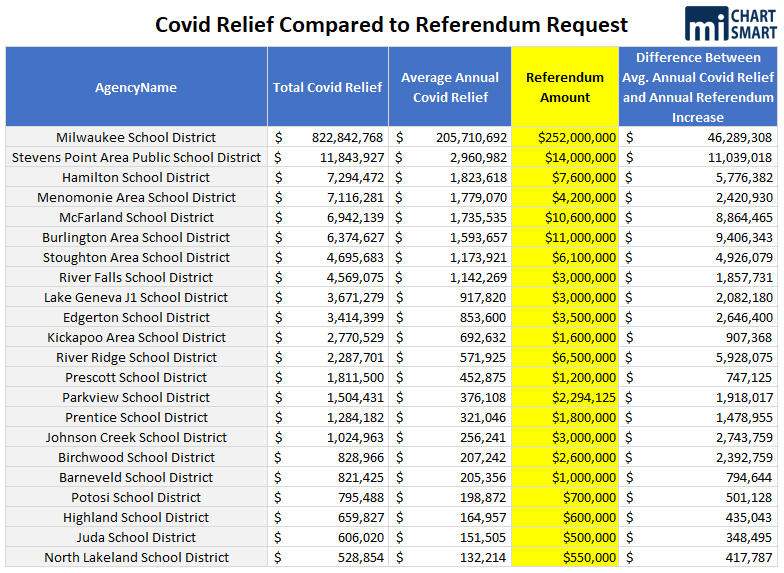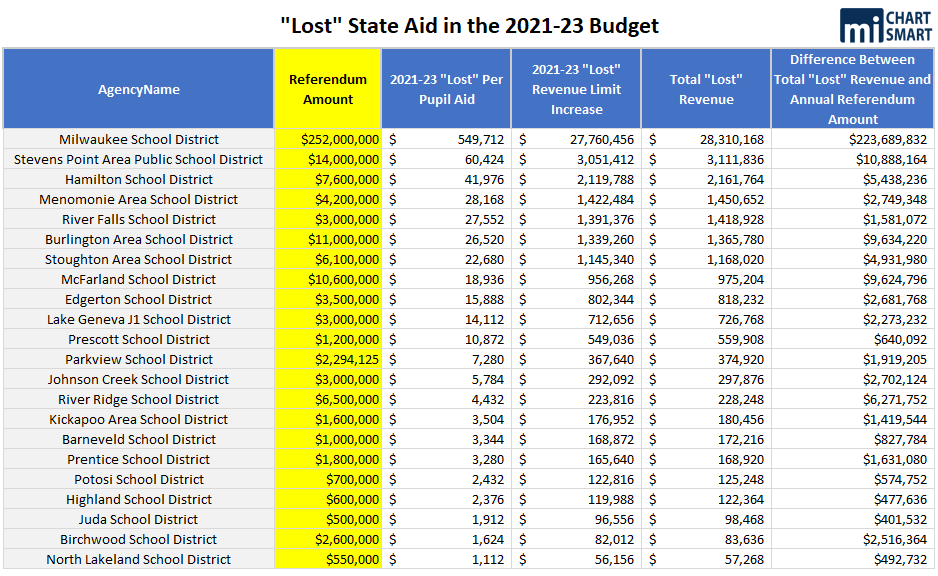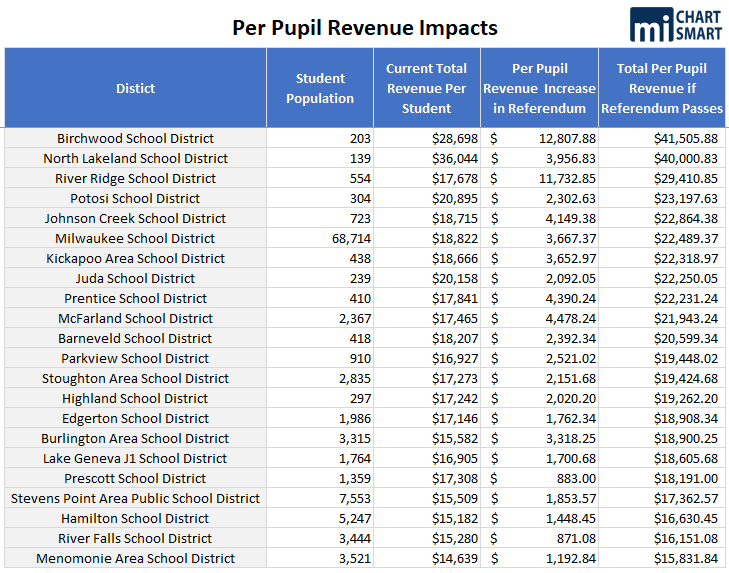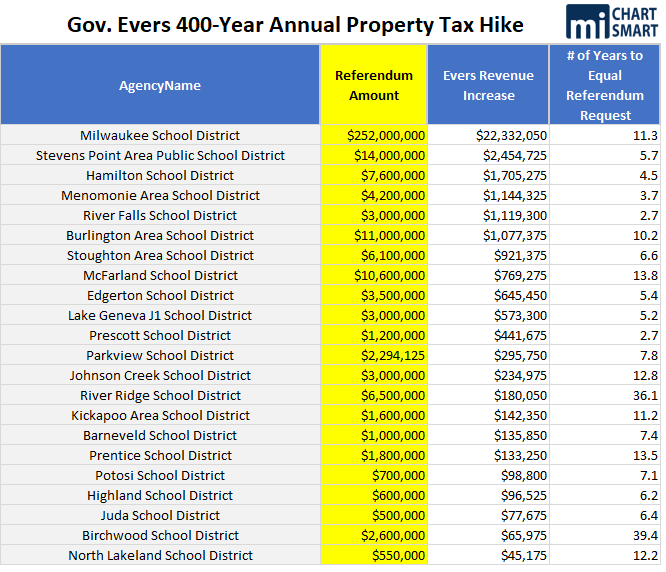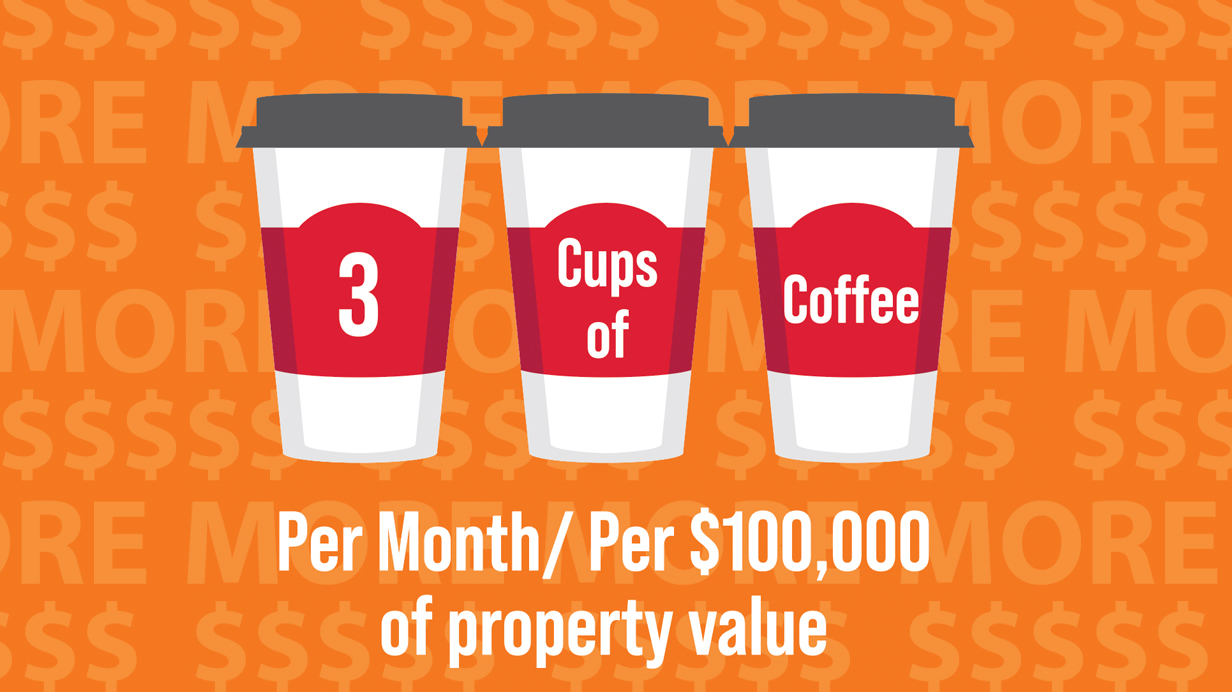
***Update – River Ridge School District told MacIver News that the wrong data was entered into DPI’s system. The superintendent doesn’t know how that happened. The referendum there would raise the revenue limit by $2 million, not $6.5 million***
Two districts would surpass $40,000 of revenue per pupil per year
One district would double its revenue limit
On average, districts seeking to replace expiring covid aid are asking for five times that amount
Feb. 27, 2024
By Bill Osmulski
School districts across Wisconsin are once again looking for scapegoats as to why they’re supposedly broke and need taxpayers to bail them out.
There are 421 school districts in Wisconsin, and 91 of them are going to referendum this spring. That includes questions to issue debt, to incur non-recurring revenue increases and to incur recurring revenue increases. The total amount on paper is listed as $1.67 billion, but in reality, it’s actually much more. That’s because the amounts listed for the recurring referendums aren’t just one-time checks. They are recurring, which means those districts plan to collect those amounts from taxpayers each and every year forever.
There are 22 school districts going for recurring referendums this spring with a total dollar amount of $337 million. For many of them, that would result in a lucrative new stream of revenue at the expense of local taxpayers. None of them offer the appropriate context for what they’re actually asking for.
Missing Context
The state limits how much revenue each school district is allowed to collect each year as a way to protect property taxpayers. After those school districts collect all their aid from the state, they get to collect the rest of their limit from property taxpayers. Calculating each district’s revenue limit is complicated, because several revenue sources (like federal aid) don’t count towards that limit. Fortunately, it’s the Department of Public Instruction’s (DPI) job to calculate those limits, and the agency makes that information easily accessible.
The MacIver Institute compared the current revenue limits with the recurring referendum requests to see how much of an increase those 22 districts are actually trying to achieve. In that sense, River Ridge School District is reaching the highest. Its current revenue limit is $6.4 million, and it wants to increase that by $6.5 million for a total limit of $12.9 million. That’s a 101% increase. If passed, it would result in a whopping $29,410 in total revenue per pupil for its 554 students.
Next up is the Birchwood School District. Its current revenue limit is $4 million. It’s asking for $2.6 million, which would increase its revenue limit by 66% to $6.5 million. (That would drop to $5.4 million when its current non-recurring referendum expires in a couple of years). Its revenue per pupil would top $41,500, the highest in the state. That’s more than enough to pay for the in-state tuition for a four-year degree at most campuses in the UW-System.
If North Lakeland’s referendum passes, it would have the second highest per pupil revenue out of the 22 districts. Its asking for $550,000 in addition to its current limit of $2.8 million. That’s a potential 20% increase to its revenue limit for a total of $3.4 million. The district only has 125 students, and North Lakeland is already spending over $36,000 per student per year. That’s currently the highest level of per pupil support in the state, and If its referendum passes, total per pupil revenue at North Lakeland could reach $40,000 a year.
Milwaukee Public Schools is asking for the largest raw dollar amount. Its $252 million request would raise the MPS’s revenue limit by 29% for a total of $1.13 billion.
Immediate Cause
Over the past 4 years, public K12 schools in Wisconsin raked in $2.9 billion in federal covid aid. Everyone knew that the federal covid relief aid wasn’t going to last forever, and its purpose was to help schools “respond to changes in student needs due to COVID-19,” according to DPI.
However, in many districts, the one-time funds fueled permanent spending increases. Federal aid is not subject to school district revenue limits. Now that the federal aid is gone, for many districts the only way they can sustain that level of spending is by raising their revenue limits, which requires a referendum.
Take for example, Stevens Point’s situation. In 2018-19, Stevens Point’s revenue limit was $75 million, which was 88% of its total revenue. In 2022-23, its revenue limit was $78 million, which now was only 82% of its total revenue, due to the large influx of federal covid aid. In 2018-19, its expenses exceeded its revenue limit by $10 million. This year, that deficit has grown to $23 million. Its $14 million referendum would bring that back down to manageable levels and increase its revenue limit by 18%.
Another big problem is that schools say that DPI directed them to spend the funds to fill budget gaps. Many districts followed that advice, plowing the one-time revenue into ongoing operations that had nothing to do with addressing the disruptions caused by covid. The consequences were predictable and inevitable.
“Over the past two years, school districts across Wisconsin had to rely on pandemic funding for operating,” explained Joe Zydowsky, Menomonie superintendent. “In the new biennial budget, schools did receive some new revenue, but that revenue is not sufficient for dealing with the expiring pandemic money and most of all the high level of inflation.”
It’s a sad excuse, and it does not even stand up to much scrutiny. Every school district asking for a recurring referendum this year is asking for far more than it lost in average annual covid relief. On average, the districts are asking for 5 times what they’ll be losing from the expiring federal aid.
Menomonie Area Schools got a total of $7.1 million in covid aid over those four years, which averages out to $1.8 million a year. It wants $4.2 million a year from voters from now on., which would increase its revenue limit by 12%.
Three districts are requesting more than ten times what they’re losing in covid aid. Johnson Creek is losing an average of $251,241 a year in covid aid, and it’s asking for $3 million a year in recurring revenue. River Ridge is losing $571,925 in covid aid and wants $6.5 million a year in recurring revenue. Birchwood Schools is only losing an average of $207,242 a year in covid aid. It’s asking for $2.6 million a year in its referendum.
The Stoughton Area School District got $4.7 million over those four years, an average of $1.2 million a year. Now that it’s gone, the district is asking voters for an extra $6.1 million every year going forward, which would increase its revenue limit by 18%.
“The district is using one-time COVID relief funds to balance its budget. This strategy was adopted when the state directed districts to use these funds in lieu of increases in revenue limits and per pupil aid in the 2021-23 state budget,” Ericka Pickett, director of business services, explained in a Jan. 25th video.
Rationalization
Stoughton blaming the state for not increasing per pupil aid two budgets ago is a fairly common excuse around the state for why districts need enormous increases in their revenue limits.
In the 2021-23 state budget, Gov. Evers wanted to increase per pupil aid from $742 to $750 a year, an $8 increase. He also wanted to increase the revenue limits for school districts by $404 per pupil over the course of the biennium, which would have been collected by raising property taxes. The legislature rejected both of those proposals.
With a student population of 2,871, that additional revenue would have been worth $1.2 million a year for Stoughton. If you include the lost covid aid that was worth $1.2 million, the district is hypothetically out $2.4 million a year. Again, its referendum is for $6.1 million a year.
Other school districts keep their complaints more general, lamenting about “stagnant education funding from the state Legislature,” like Birchwood Schools. That claim would be laughable if it wasn’t so dishonest. Total state spending on education this budget increased by 6.9%. Total state spending in the last budget increased by 4.8%. The budget before that increased state education spending by 5.8%. The reality is that every budget routinely includes an “historic” increase in public education funding.
The reason why Birchwood’s share of that funding is “stagnant” is because it’s a “property rich and income poor district,” which Birchwood would lead you to believe is a bad thing for its bottom line.
“The School District of Birchwood continues to feel the impact of being a zero-aided district, meaning it receives virtually no Wisconsin general aid,” Birchwood Schools claims.
Don’t be fooled. The district is actually in an enviable position. Being “property rich and income poor” results in Birchwood collecting $28,698 in revenue per pupil, the 8th highest rate in the state. Apparently, it’s still not enough. The district’s $2.6 million referendum would increase per pupil revenue by $12,800, resulting in total per pupil revenue potentially exceeding $40,000.
While Birchwood is being deceptive about the impact of its state support, Stevens Point chose to outright lie about its level of state support.
“Due to the state’s inequitable school funding formula and a lack of adequate funding for public schools in recent years, districts like SPAPSD increasingly have needed to turn to their local communities for the support they need. The responsibility to fund our schools is increasingly on local property taxpayers.” according to Stevens Point.
In reality, state support to Stevens Point has increased by 38%, or $16.3 million, since 2017-18, according to its own budgets.
Classic Misdirection
Birchwood’s focus on its lack of state aid is a classic example of misdirection. This tactic is a favorite among school districts trying to sell the public on a referendum. The trick is to provide only a partial picture of their finances in order to paint a bleak picture.
Edgerton Schools choose this tactic when it claimed to only get $11,064 in revenue per pupil, the lowest among the five surrounding school districts. “In fact, the Edgerton School District was ranked 309th of 421 school districts in Wisconsin with low per-student support,” according to superintendent Dennis Pauli.
Had Edgerton chosen to provide the complete picture, it would have stated that it collects $17,146 in revenue per pupil, which is higher than two of the surrounding districts and ranks 205th in the state overall.
Edgerton is asking voters for an extra $3.5 million annually, which would raise its revenue limit by 17%, increasing per pupil revenue by $1,762. That would be the higher than any of the surrounding districts and 90th in the state overall.
Evers’ 400-Year Increase
The one thing every school district has conveniently forgotten about when complaining about stagnant state aid is Gov. Evers’ 400-year school funding increase. Through the creative and highly unconstitutional use of his line-item veto, Evers raised every district’s revenue limit by $325 per pupil every year for the next 400 years. There is no state funding attached to that increase, which means it will come out of local property taxpayers’ pockets.
That will already raise those 22 districts’ revenue limits by an average of 3% before they go to referendum this spring. For Milwaukee, it adds up to $22.3 million. In Stevens Point, it’s worth $2.5 million; $1.7 million in Hamilton; $1.1 million in Menomonie; $1.1 in River Falls; and $1 million in Burlington. In Prescott, Evers’ per pupil increase is worth $441,675, which is equal to 37% of the district’s $1.2 million referendum.
Eventually, Evers’ annual revenue limit hike will equal the same amount these districts are requesting in their referendums. For example, even if River Falls’ $3 million referendum failed, the district would still have been able to raise property taxes by $3 million within 3 years. Also, Evers’ revenue limit hike wouldn’t stop at $3 million. As long as River Falls has 3,444 students, the revenue limit will increase by another $1.1 million every single year for the next 400 years.
Early Results
Recurring operating referendums historically have a high success rate in Wisconsin. Since 2020, 70% of them have passed. However, 2024 could be a tough year to convince voters to raise their own taxes.
Three of the 22 districts held their recurring referendums during the February primary, and two of them failed. Referendums always have a better chance for success in primaries than in general elections.
River Falls’ $3 million referendum passed with 57% vote. Burlington’s $11 million referendum failed with only 47% of the vote, and Menomonie’s $4.2 million referendum was soundly rejected with only 41% support.
Unfortunately, voters rarely get the final word on school referendums unless they vote yes. State law allows districts to go to referendum twice a year for the same question. River Ridge already plans to go back to voters again in August or November if the referendum fails this time around.
